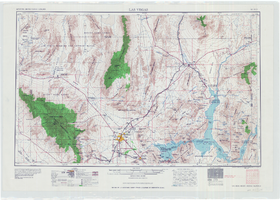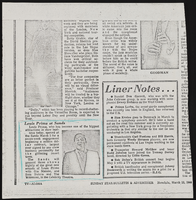Search the Special Collections and Archives Portal
Search Results

Topographic map of the Las Vegas Valley area, 1959
Date
Description
Image

Transcript of interview with Sharon Maurer-Schwartz and Edna Rice by Barbara Tabach, February 1, 2016
Date
Archival Collection
Description
Born in 1939, Sharon Maurer-Schwartz’s life experiences have traversed a groundbreaking era: she’s a female, Jewish and a married to a Protestant lesbian. This oral history reveals what it has been like for her as she explored her Judaism and recognized her personal identity. Her Judaic foundation began in the Reconstructionist movement in Indianapolis, Indiana. She has never wavered from her religious identity, though she has belonged to various types of synagogues. She and Ande (Edna) Rice, who also participates in this interview, were legally married in California in 2008, but have been together since the 1980s. They raised Sharon’s daughter Julie, pursued careers and moved to Las Vegas in 1999. Ande is a Protestant and the topic of blended religious couples is discussed. Sharon is devoted to her life coaching business – Growth Unlimited – and to helping others.
Text

Timothy Dickhudt oral history interview: transcript
Date
Archival Collection
Description
Oral history interview with Timothy Dickhudt conducted by Barbara Tabach on March 13, 2018 for the Remembering 1 October Oral History Project. In this interview, Timothy Dickhudt discusses his move to Las Vegas, Nevada in 2017 for a fellowship at the University Medical Center in Southern Nevada (UMC). He describes the night of the October 1, 2017 mass shooting, how he was called into work almost immediately after he arrived home from his shift, and his gradual understanding that a mass shooting had occurred on the Las Vegas Strip. Dickhudt also talks about operating on a family acquaintance from his home state of Minnesota who had attended the concert.
Text

Emilia Marquez oral history interview: transcript
Date
Archival Collection
Description
Oral history interview with Emilia Marquez conducted by Maribel Estrada Calderón on July 5, 2019 for the Latinx Voices of Southern Nevada Oral History Project. Claytee D. White and Emily Lucile are also present during the interview. Emilia Marquez was born in the United Stated and raised in Alexandria, Virginia, where her father worked as a bricklayer, until the age of twelve, when her father decided to move the family back to Uruguay. She describes acclimating to her new life in middle school and her shift from being perceived as an outsider in Uruguay to accepting Uruguay as home. She describes life in Uruguay and the positions that her family held while living there. After meeting and marrying her husband they trained to work in a casino. She trained as a slot machine operator, and her husband trained as a dealer. This eventually led them to leave Uruguay for the U.S. After the encouragement of her father and mother, she moved with her mother to Las Vegas to work in the casino industry. She describes working as a change person at the Luxor before moving to the newly opened Palms, where she worked until she left it to work at the Wynn. She ends the interview talking about various Uruguayan dishes and traditions, and a brief history of Uruguay. Subjects discussed in this interview: Uruguay, immigration, Las Vegas Strip, Latinx, Luxor.
Text
Anna Bailey oral history interview
Identifier
Abstract
Oral history interview with Anna Bailey conducted by Claytee White on March 03, 1997 for the Women's Research Institute of Nevada (WRIN) Las Vegas Women Oral History Project. Bailey opens her interview by describing her early life, family, and dance training. She discusses moving to Los Angeles, California at age fifteen, her first dancing gigs, and touring in London, England. She also talks about her experiences as an African American dancer including issues with segregation while touring in the southern United States. Bailey then discusses her life in Las Vegas, Nevada in the 1950s, and working as a dancer at the Moulin Rouge. She describes the club, the other dancers that performed there, and how the African American community felt when the club closed. Bailey then discusses how her husband and the entertainers Josephine Baker and Frank Sinatra helped integrate Las Vegas. She ends her interview by describing the last hotel she danced at, the Flamingo, where she performed in an integrated dance line.
Archival Collection
Hattie Canty oral history interview
Identifier
Abstract
Oral history interview with Hattie Canty conducted by Claytee White on February 27 and June 17, 1998 for the Las Vegas Women Oral History Project. In this interview, Hattie Canty recalls moving to Las Vegas, Nevada in the late 1960s and working as a maid for the Thunderbird Hotel and Casino and later the Maxim Hotel and Casino. Canty discusses her tenure as the Culinary Union Local 226 President during which she faced several labor challenges and went to jail at least six times while striking. Hattie also recalls how she influenced contract negotiations for the downtown hotels, improved race relations among workers, involved more members in union operations, and implemented the Culinary Training School.
Archival Collection




